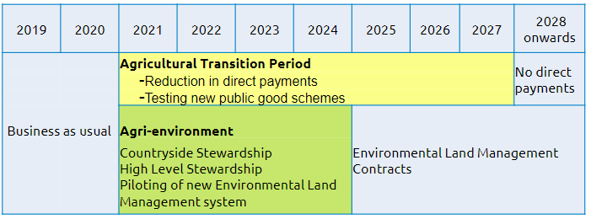New details on ELMs design
Wednesday, 26 February 2020
Defra has today revealed new details about how new Environmental Land Management schemes (ELMs) may operate when they are introduced in 2024. ELMs are currently in the first phase of trials with the national pilot due to begin in late 2021. These trials are being used to inform the scheme’s design and new proposals represent current thinking of how the scheme will look.

Over seven years, the government plans to phase out the Basic Payment Scheme (BPS) and replace it with payments made through ELMs and based on the principle of public money for public goods. Basic payments amount to around half of the average farm business’s income, though this varies a lot by sector, with BPS much more important to cereal farms than pigs or poultry. The design of ELMs will therefore be of crucial importance to some sectors as they transition to new sources of income.

Tiered system
Under the new proposals, there will be three tiers of the scheme, which broadly address desired outcomes at different scales.
Tier 1
The first tier will focus on farm-level improvements by paying farmers to adopt or continue practices that achieve environmental benefits and improve sustainability, such as cover crops or wildflower margins. There will be a focus on practices that are most effective when delivered at scale.
Tier 2
This tier will focus on locally targeted environmental outcomes, taking into account priorities in the local area. Collaboration between land managers will be important for achieving outcomes in this scheme, so there will be mechanisms to encourage and reward join-up between farmers, foresters and other land managers.
Tier 3
The UK has committed to achieving net zero carbon emissions by 2050. The third tier of the scheme will focus on large-scale land-use change projects that will contribute to this commitment and others. Many projects in this scheme could therefore be expected to focus on carbon storage, whether in creating woodlands, restoring peatlands or creating new wetlands and salt marshes. As well as storing carbon, these schemes are expected to deliver additional environmental outcomes, for instance in biodiversity and flood mitigation.
Scheme simplification
Defra is currently considering the benefits of grouping different options together (particularly in tier 1) into packages which applicants could choose between. This would aim to simplify a very broad range of potential options, and packages would be tailored to farm type, land type or particular outcomes. For example, farmers in upland areas could apply for a specific upland package which contains a number of different actions designed to improve upland environments.
Advice and support
Defra has recognised the importance of advisers in helping to deliver successful environmental schemes. Advisers may provide tailored support to address gaps in the skills and knowledge of land managers and will help to facilitate collaboration. A range of options is being looked at, including one-to-one support for land managers, group advice and training, telephone and online support or peer-to-peer learning.
Payment
A number of options for payment are being explored, including administrative price setting, where payment rates are set by government, or market-based price setting, where prices are determined by a competitive market with tendering or auctions. Another option being explored is payment-by-results, though some environmental outcomes will be very long term.
Consultation
Defra has launched an open call for opinions on the initial proposals revealed today. To participate in this policy discussion, click here. To read the full statement, click here.
Visit https://ahdb.org.uk/brexit for information on how to prepare for change and make your farm business fit for the future.
Topics:
Sectors:
Tags:


